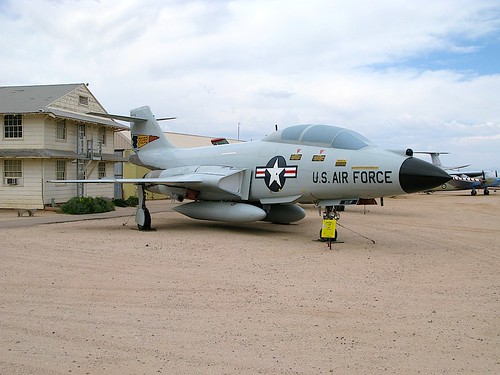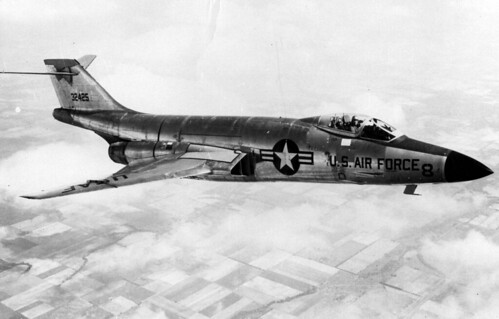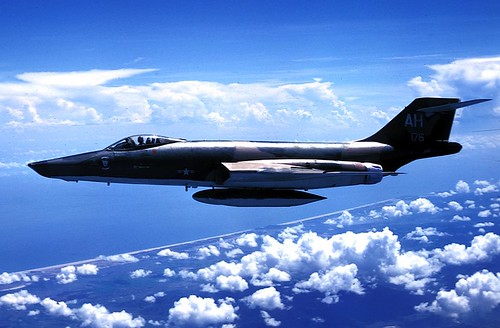Time for another Air-Minded diary? Sure it is. This time let’s take a look at a Century Series fighter from the 1950s, the McDonnell F-101 Voodoo. There were three distinct variations of the Voodoo — a fighter-bomber, a tactical reconnaissance aircraft, and an air defense interceptor — but I’m going to concentrate on the interceptor, the F-101B.

Why this aircraft? The Pima Air & Space Museum, where I volunteer as a walking tour docent, has a nicely-preserved F-101B interceptor on display. The aircraft was still in operational service during the first half of my USAF career, and I know a few pilots who flew it. Good reasons right there. Here’s another: when I flew the F-15 Eagle, my fellow fighter pilots often expressed a half-joking, half-serious disdain for interceptors and the crews who flew them. I never got that, and refused to play along. I guess I’m still resisting that particular institutional prejudice.
When I started researching the One-Oh-Wonder so much interesting information came to light it almost stopped me in my tracks. What to focus on? The USAF’s WWII-formed conviction that bombers needed long-range escort fighters? The astounding number of Eisenhower-era strike fighters designed to deliver tactical nuclear bombs? The early development of air-to-air missiles and the decision to build fighters without guns? The evolution of USAF fighters from probe & drogue to boom aerial refueling? The distinctions, which I have already alluded to, between interceptors and fighters? All that would be too much for one post. I’ll try to focus on the F-101B interceptor, but I can’t get there from here without at least touching on those other areas, which I’ll come back to and expand on in future entries.

In the aftermath of WWII, the newly-formed US Air Force wanted long-range escort fighters to accompany and protect our bombers. These were the days before air-to-air missiles, when escort fighters were armed only with guns. The McDonnell XF-88 prototype won a 1948 fly-off competition, even though it was underpowered and subsonic, but when the Soviet Union detonated its first nuclear bomb one year later the USAF decided to put its money on interceptors to stop Russian bombers intent on attacking us, not escorts for American bombers attacking them, and the XF-88 program was suspended. During the Korean war USAF generals began to worry about the safety of American bombers again and decided to spend money on escort fighters after all. It issued a new requirement in 1951 and McDonnell submitted a redesigned version of the XF-88, a larger, more powerful, supersonic aircraft subsequently redesignated the F-101A, first delivered to the USAF in 1954.
The USAF didn’t put the F-101As into service until 1957, when interest in long-range escort fighters had once again cooled. Why the delay? Development problems, most famously the Voodoo’s dangerous tendency to pitch up at high angles of attack, caused by turbulent air from the wings “blanketing out” the T-tail elevators and making them ineffective. This problem was never entirely overcome, and all versions of the F-101 were considered tricky jets to fly.
By 1954 USAF priorities had shifted back to interceptors, and the hot project was the F-102 Delta Dagger. The first F-101As to enter operational service were long-range escort fighters, armed with guns, just as their XF-88 predecessor had been (the F-101A was capable of carrying the new AIM-4 Falcon air-to-air missile, but never did). An indication of the USAF’s loss of interest in the long-range escort fighter concept is the fact that it didn’t employ the F-101A as one; instead it made it a penetration fighter, armed with a single tactical nuclear bomb. The F-101A’s career was a short one: it never saw combat and was phased out of the inventory in 1966.

The tactical reconnaissance Voodoo, the RF-101, was developed at the same time as the F-101A fighter. Like the fighter, it was a single-seat aircraft, but with a modified nose section containing camera equipment. It did not have guns, but (oddly) retained the capability to carry the tactical nuclear bomb on the fuselage centerline (a capability which, to my knowledge, was never used). A few RF-101As were built, but the predominant version was the RF-101C, which flew from 1958 to 1972. RF-101Cs flew low altitude high speed passes over Soviet missile emplacements in Cuba in 1962, giving President Kennedy the photographic proof he needed to confront the Russians, and later flew combat reconnaissance missions during the Vietnam conflict.

The USAF’s first air defense interceptors were the F-94 Starfire and F-89 Scorpion, subsonic jet fighters armed with unguided rockets. Although these aircraft were equipped with small on-board radars, they were dependent on ground radar controllers to vector them into a position a mile or less behind enemy aircraft, from which point they would theoretically launch their rockets at the target. The F-102 Delta Dagger, under development in the early to mid-1950s, was to be a more formidable interceptor, capable of supersonic flight, able to operate autonomously with a more powerful on-board radar, and armed with the first generation of radar-guided and heat-seeking air-to-air missiles. The first F-102s, however, were not capable of supersonic flight and had to be extensively redesigned. In the interim, the USAF gave the go-ahead to development of an interceptor based on McDonnell’s Voodoo. After all, here was a proven supersonic fighter that already had the capability to carry early air-to-air missiles in internal bays. All it needed was a radar.
The F-101B became that interceptor. Extensively redesigned to accommodate a two-man crew and a large radar and fire control system, the first F-101Bs also had more powerful engines with longer afterburners (rather than redesign the aft section of the fuselage, McDonnell simply left the longer afterburner cans sticking out behind, as you can see in the photo below). The installation of an aft cockpit resulted in slightly less internal fuel capacity than in the single-seat fighter and recce versions, although this was partially made up for with belly-mounted external fuel tanks. The radar and fire control system replaced the fighter version’s cannons, leaving the F-101B armed only with missiles: four AIM-4 Falcons on two rotating launchers mounted inside the lower fuselage between the external fuel tanks: each launcher held one AIM-4A semi-active radar homing missile and one AIM-4B infrared-guided missile. The missiles were short-range weapons: max range was around four miles. Nor were they very good. Firing doctrine called for launching two missiles at each target: one radar and one heat-seeker. Some F-101Bs carried, in place of two of its AIM-4 Falcons, two 1.5-kiloton nuclear-tipped AIR-2 Genies, truly frightening weapons. These unguided rockets were designed to be launched into formations of enemy bombers at what by today’s standards would be extremely short range, just six miles. F-101B aircrews trained to fly right at the enemy, launch the Genie, then pull the world’s fastest split-S to get out of the way of the detonation!
Because USAF air refueling systems were still evolving, fighter and recce single-seater Voodoos were equipped with two separate air refueling systems: a retractable nose-mounted probe in the nose for use with drogue-equipped tankers, and a slipway aft of the cockpit for use with boom-equipped tankers. Early versions of the F-101B interceptor retained the nose-mounted air refueling probe, but starting in the early 1960s it was replaced with an infrared seeker unit (visible in both F-101B photos as a bump on the upper nose, just aft of the radome). Interestingly, I cannot find any evidence the the F-101B interceptor was air refuelable. F-101Bs, as mentioned, briefly had retractable nose probes, but did they ever have slipway refueling receptacles? All I can find is one cryptic reference to a pair of F-101Bs, part of the Lockheed Blackbird flight test support fleet at Nevada’s Groom Lake test facility (aka Area 51), that had been “modified for Boom Refueling,” which leads me to think that normal F-101Bs were not capable of boom refueling. In my research I found plenty of photos of F-101As and RF-101Cs refueling, but no photos of the F-101B refueling — nor can I see a slipway door behind the cockpit of my museum’s F-101B. Even so, I have a hard time believing the F-101B was not air refuelable, and I hope someone can point me to better sources of information.
The F-101B never saw combat. It never shot down an enemy aircraft. It never deployed outside the continental US, other than the 80 or so CF-101 versions operated by the Royal Canadian Air Force (which never saw combat either). It served the air defense commands of both countries faithfully and well, but never fired a shot in anger.

Another interesting item: as an interceptor the F-101B did not, after all, operate autonomously (neither did the F-102). The on-board radar, though far more advanced than those that came before it, still could only pick up targets at relatively close range, and in practice F-101B aircrews had to be vectored toward airborne targets by ground-based radar controllers. Not only that, the Voodoo was wired to operate by datalink with the SAGE (semi-automated ground environment) radar system, which meant that radar controllers on the ground could take control of the aircraft and fly it to the missile launch point, at which time the aircrew would resume control, lock up the target, and simulate launching their missiles.
And here, I think, is the root of the antipathy fighter pilots felt toward interceptor pilots: the fact that ground controllers — non-pilots — could take control of interceptor aircraft and fly them to the target. Never mind that “pure fighters” of the era were wired for SAGE as well, or that their radars weren’t any better. Never mind that the first USAF F-4s also came without guns, carried the same crappy AIM-4 Falcon missiles, and were in fact designed as interceptors. If you flew F-101s, F-102s, or F-106s for Air Defense Command, you were a “conehead.” If you flew F-100s, F-104s, F-105s, or F-4s for Tactical Air Command, you were a fighter pilot. The only interceptor pilots to escape censure were the F-102 jocks who flew in Vietnam — early in that war we deployed F-102s to Clark and Da Nang to intercept an anticipated North Vietnamese bomber threat; when it turned out there was no threat, the F-102s flew escort for B-52 bombing missions in the north, and some were lost in combat.
They used to train F-101B aircrews and F-106 pilots at Tyndall AFB on the Florida panhandle (today F-15, F-22, and F-35 pilots train there). I flew into Tyndall once and watched a number of F-101Bs take off and land. The Voodoo was a fast jet, definitely a Century-series design: it flew final and landed at higher airspeeds than the F-15, and needed a drag chute to help it slow down once it was on the runway. What impressed me most, though, were its über-manly afterburners. The F-15, and other more modern fighters, have multi-stage afterburners that light off with a series of muffled thumps. The Voodoo had single-stage burners famous for lighting hard: when they lit they went BA-BOOM! I, for one, thought it was a really cool jet.
Links:
- Wikipedia on the F-101 family
- Air Vectors on the F-101 family
- Joe Baugher on the F-101B
- Air Power Australia on the Hughes Falcon missiles
Additional images (on Flickr):